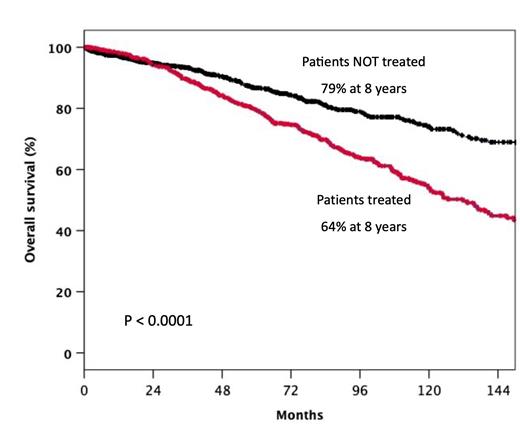Introduction: Chronic lymphocytic leukemia (CLL) exhibits diverse treatment requirements, with some patients receiving immediate treatment while others remain under observation. In 2008, the International Workshop on Chronic Lymphocytic Leukemia (IWCLL) established criteria for treatment indications, widely adopted in clinical practice and trials. The Brazilian Group of CLL (BGCLL) has been evaluating a more conservative approach to treatment indication performed in multiple centers, which avoids predefined cutoff levels for cytopenias and refrains from considering progressive lymphocytosis, extranodal involvement, or disease-related symptoms as isolated criteria. However, the safety and potential different outcomes of this conservative approach compared to the strict IWCLL criteria remain uncertain. Objective: This study aims to compare the outcomes of CLL patients without indication for treatment according to the BGCLL criteria, who were either treated or not based on the center's decision.
Methods: We conducted a retrospective analysis of CLL patients enrolled in the Brazilian Registry of CLL, observed between January 2009 and March 2023, meeting the minimum data availability criteria for analysis and following IWCLL inclusion guidelines.
Results: A total of 2396 patients from 41 centers were included. Among them, 1313 patients (55%) met the IWCLL criteria for treatment indication, while only 558 patients (23%) fulfilled the more conservative BGCLL indication. Of the 1240 untreated patients, 247 (20%) had a treatment indication based on IWCLL guidelines. Common indications for treatment initiation included cytopenias in 159 patients (64%), disease-related constitutional symptoms in 41 patients (17%), and symptomatic lymphadenopathy in 22 patients (9%). Non-treatment despite having an indication was attributed to BGCLL's more conservative criteria in 67% of cases, severe comorbidities in 6%, and death during follow-up in 27%. Among the 1156 treated patients, 90 patients (8%) received treatment despite lacking a treatment indication according to the IWCLL criteria. According to BGCLL's conservative criteria, 600 (48%) treated patients did not have a treatment indication. After a median follow-up of 58 months (range: 3-506), the overall survival (OS) was 70% at 8 years. Among patients without an indication for treatment according to BGCLL's conservative criteria, OS was significantly worse in treated patients (79%) compared to untreated patients (64%, P<0.0001, figure 1).
Conclusion: These real-world data demonstrate that a conservative approach in indicating first-line treatment for CLL is safe and associated with improved survival, possibly by mitigating toxicities and treatment-related complications such as clonal selection. Furthermore, this strategy may conserve resources, enhancing drug accessibility for a larger number of patients in clear need of treatment, particularly in low-income countries.
Disclosures
Chiattone:ROCHE, ABBVIE, JANSSEN, AZ, LYLLI, TAKEDA: Consultancy; ROCHE, ABBVIE, JANSSEN, AZ, LYLLI, TAKEDA: Honoraria.


This feature is available to Subscribers Only
Sign In or Create an Account Close Modal